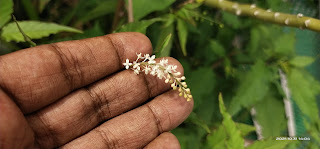INTRODUCTION:
Blood Berry is a native plant in the US regions surrounding Southern & Central America, Carribean and South America - very much grows around the tropical region around the world, however it is considered more of an invasive weed in other parts of the world where it was introduced as an ornamental plant around the 1900. Now it is no longer sold in nurseries as an ornamental plant due to its invasive/weed factor where it is very easy to grow and found almost like a weed in most places.
However do not discount the fact that this was an ornamental plant which was highly sought after during the 1900 all around the world - and hence due this factor, this particular plant made it's home all over the world, circulating around the tropical belt.
Other common names of this plant: Pigeon berry, rouge plant, baby pepper and coral berry. I'm pretty sure it also have other native names which would be too much to detail here.
CHARACTERISTICS:
One thing for sure, unlike most berries like plant which may require a lot care and in most cases very much belonged to the temperate regions - this particular one is extremely hardy. At most, I can say, almost no care is needed - hence the one reason where it is considered invasive due to the factor of it's hardiness and ability to grow well and stay strong in its growing spot.
This ornamental plant is mainly planted to for the showy red berries like features giving that exclusive miniature tomato like features and somehow I find that non of the insects nor animals seemed to be interested to consume or disturb this plant - hence you may not really be worried about using pesticides or plant care.
Also it does have many hardy features as shade tolerant - hot direct sun expose plant.
Although a lot have been said concerning these invasive weed factor, personally I find that this particular plant seemed to be rare in appearance and strangely more on a sensitive plant which can be easily killed and may not be that hardy - just like any ornamental plant, this one is in that category.
TOXICITY:
There is a bit of contention in some part of the world to eradicate this plant as it's an invasive weed. On another factor, in some cases - it is considered medicinal where the leaves are used as tea for ailments however the berries were said to be toxic. Another website mentioned that the berries were tested on rats and it is said that it is safe if consumed.
Another factor which is equally confusing is that these plants are dispersed by birds feeding on the berries most often the spread of plants appear after the bird droppings eaten by pigeons, quails and fowl species. This seemed to contradict the toxicity of the plant.
Apart from the toxicity these berries were made in good use where once it was used as dye and ink.
Whatever the case, I do not recommend this plant for any consumption rather purely for ornamental / decorative purposes only.
PROPAGATION:
I had find that it is easy to propagate both using seeds and cuttings which will grow successfully with the right conditions. These can easily wither away if they do not receive adequate watering - hence the sensitive side, not very much a dry or a succulent type.
SOIL MEDIUM & WATERING:
Grows well in a balance well mix potting medium however it can even grow well in poor soil conditions - however not a big fan of a wet feet - won't do so well in extreme wet muddy soil or extremely dry soil (like the ones used for cacti/succulent)
It may need almost daily watering as it is a soft stem plant - being very much like a perennial herb, may not thrive in desert like dry conditions.
PEST:
So far, I have not found any insects or animals interested to consume this plant..
However I had noticed many nectar drinking insects especially bees and butterflies frequently visit the flowers for pollination.
PLANT FEATURES:
Apart from the berry like showy features, this particular plant is not fragrant. Also the berries do seemed to be fragile - able to detach easily and fall in the slightest touch or disturbance. I also noticed that these berries are actually a full seed covered with a thin layer of red skin, hence there are not much of pulp or anything significant to consider to taste (not even sweet) hence its just an attractive colored fruit seed.
NECTAR DRINKING INSECTS:
This is how the flowers looks like - these tiny inflorescence appears to be very insignificant in comparison the berries.
I would truly recommend these for butterfly conservation works as I find these seems to be very much like a butterfly magnet.
I had noticed not much of research had been done except the negative connotation of being treated as a weed plant which made this plant very much identified as a toxic and invasive plant, hence the plant had fallen from favor and grace of which once it was highly favored which made itself known all around the world.
I had noticed not much of research had been done except the negative connotation of being treated as a weed plant which made this plant very much identified as a toxic and invasive plant, hence the plant had fallen from favor and grace of which once it was highly favored which made itself known all around the world.

























No comments:
Post a Comment